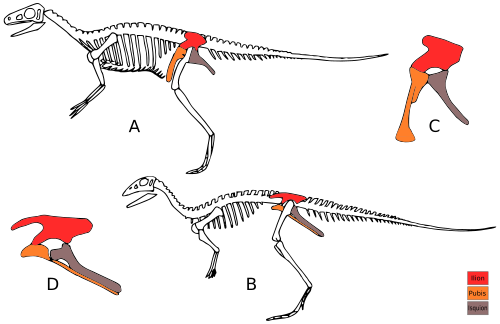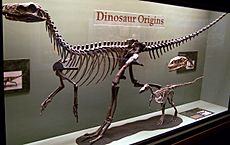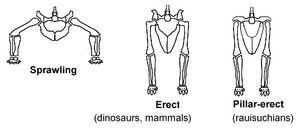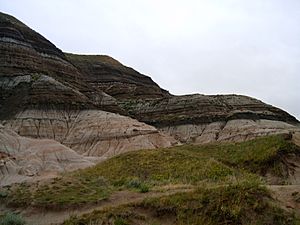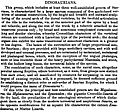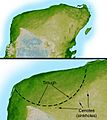Dinosaur facts for kids
Quick facts for kids Dinosaurs |
|
|---|---|
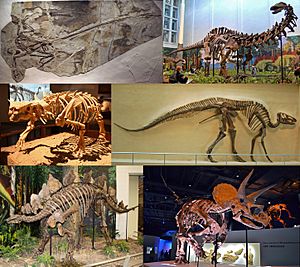 |
|
| A collection of fossil dinosaur skeletons. Clockwise from top left: Microraptor gui (a winged theropod), Apatosaurus louisae (a giant sauropod), Edmontosaurus regalis (a duck-billed ornithopod), Triceratops horridus (a horned ceratopsian), Stegosaurus stenops (a plated stegosaur), Pinacosaurus grangeri (an armored ankylosaur) | |
| Scientific classification | |
| Major groups | |
Dinosaurs are a group of amazing reptiles that lived on Earth for millions of years. Their name, "Dinosauria," means "terrible lizards." They were the main animals on land during the Mesozoic Era, which is often called the "Age of Dinosaurs."
Scientists have found fossils of over 500 different types of dinosaurs. These fossils have been discovered on every continent, even Antarctica! New dinosaur discoveries are still happening all the time.
Dinosaurs first appeared about 230 million years ago, in the Upper Triassic period. Early dinosaurs like Eoraptor and Herrerasaurus lived in what is now South America. By the early Jurassic period, dinosaurs had become the most important land animals. They lived in many different places on land. Dinosaurs continued to rule the Earth until about 66 million years ago. At that time, a big event caused most of them to die out.
Today, we know that birds are actually living feathered dinosaurs. They grew from early theropod dinosaurs during the Jurassic period. Birds are the only type of dinosaur that survived to the present day.
Dinosaurs had special features that helped them succeed. The first known dinosaurs were small meat-eaters that walked on two legs. All their later relatives had an upright way of standing, with their legs directly under their bodies. This helped them move around much better. Many smaller dinosaurs also had feathers and were likely warm-blooded. This means they were active and had a faster metabolism than modern reptiles. Some dinosaurs probably lived in herds and worked together.
People first recognized dinosaur fossils in the early 1800s. Before that, some bones were found but people didn't know what they were. Scientists like William Buckland, Gideon Mantell, and Richard Owen realized these bones belonged to a unique group of animals. Today, dinosaurs are very popular. You can see them in museums around the world. They are also a big part of movies, books, and TV shows.
Contents
What Kinds of Dinosaurs Were There?
Scientists know that all dinosaurs came from a common ancestor. This is because they share at least 21 special features in their skulls and skeletons. These shared features are called 'synapomorphies'.
When the first clear dinosaur fossils appeared in the Upper Triassic, the group had already split into two main branches: the Saurischia and the Ornithischia.
- The Saurischia, or "lizard-hipped" dinosaurs, kept the hip structure of their ancient ancestors.
- The Ornithischia, or "bird-hipped" dinosaurs, had a different hip structure.
C A saurischian pelvis (Staurikosaurus) D Lesothosaurus pelvis
How Do Scientists Classify Dinosaurs?
Here is a simplified list of the main dinosaur groups. Groups with a dagger (†) next to them are now extinct, meaning they have no living members.
- Dinosauria

-
- Saurischia ("lizard-hipped" dinosaurs)
-
- Theropoda (all walked on two legs; most were meat-eaters)
-
- †Herrerasauria (early meat-eaters that walked on two legs)
- †Coelophysoidea (small, early theropods like Coelophysis)
- †Ceratosauria (often had horns, important meat-eaters in the Cretaceous)
- Tetanurae (meaning "stiff tails"; includes most theropods)
-
- †Carnosauria (large meat-eaters like Allosaurus and Carcharodontosaurus)
- Coelurosauria (feathered theropods, came in many sizes)
-
- †Tyrannosauridae (Tyrannosaurus and its relatives)
- †Ornithomimosauria (looked like ostriches; mostly toothless)

-
-
-
-
-
- Maniraptora (meaning "hand snatchers"; had long arms and fingers)
-
- †Therizinosauria (plant-eaters with huge hand claws)
- †Oviraptorosauria (mostly toothless; their diet is still a mystery)
- †Deinonychosauria (small, bird-like, with a special toe claw, like Velociraptor)
- Avialae (modern birds and their extinct relatives)
-
-
-
-
-
-
- †Sauropodomorpha (plant-eaters with small heads, long necks, and long tails)
-
- †Plateosauridae (early "prosauropods" that walked on two legs)
- †Sauropoda (very large and heavy, often over 15 meters long; walked on four legs)
-
- †Neosauropoda ("new sauropods")
-
-
- †Diplodocoidea (had long skulls and tails; pencil-like teeth)
- †Macronaria (had boxy skulls; spoon- or pencil-shaped teeth)
-
-
-
- †Ornithischia ("bird-hipped" dinosaurs; a mix of two-legged and four-legged plant-eaters)
-
- †Thyreophora (armored dinosaurs; mostly walked on four legs)
-
- †Ankylosauria (had bony plates as armor; some had club-like tails)
- †Stegosauria (had spikes and plates as armor)
- †Ornithopoda (came in many sizes; walked on two or four legs; could chew their food well)
- †Marginocephalia (had dome-like or knobby bone growths on their skulls)
-
-
- †Pachycephalosauria (walked on two legs with domed skulls)
- †Ceratopsia (walked on four legs with frills; many also had horns, like Triceratops)
-
Where Did Dinosaurs Come From?
Dinosaur Ancestors: Archosaurs
Dinosaurs are part of a larger group of reptiles called Archosaurs. The Archosaurs split into two main groups:
- One group includes crocodiles and their relatives.
- The other group includes dinosaurs, pterosaurs (flying reptiles), and birds.
- Archosauria
- Pseudosuchia: Crocodiles and their relatives.
- Avemetatarsalia: Dinosaurs, pterosaurs, birds, and their relatives.
- Ornithodira: Pterosaurs and dinosaurs.
- Pterosaurs
- Dinosaurs
- Ornithodira: Pterosaurs and dinosaurs.
The Very First Dinosaurs
The first known dinosaurs were small meat-eaters that walked on two legs. They were usually one to two meters long.
Some of the earliest confirmed dinosaur fossils include Herrerasaurus, Eoraptor, and Staurikosaurus. These dinosaurs lived about 230 million years ago. They are considered early "lizard-hipped" dinosaurs (saurischians).
One of the earliest "bird-hipped" dinosaurs (ornithischians) is Pisanosaurus. It also lived around 230 million years ago.
Early saurischians and ornithischians looked similar in some ways. However, saurischians kept the original hip bone arrangement, while ornithischians had a different hip structure. Ornithischians also had stronger upper skulls and more flexible jaw joints. These features helped them grind plant food, as most ornithischians were plant-eaters.
How Did Dinosaurs Become So Diverse?
Dinosaurs were an incredibly varied group of animals. This variety allowed them to live in many different ecological niches, or roles in their environment. Scientists have found over 500 different types (genera) and 1,000 different species of non-bird dinosaurs. Their relatives, the birds, have about 9,000 living species today, making them the most diverse group of land animals.
The largest dinosaurs were plant-eaters, like Apatosaurus and Brachiosaurus. They were the biggest animals to ever walk on land. Other plant-eaters, like Iguanodon, had special ways to defend themselves from meat-eaters. For example, Triceratops had three horns and a big neck frill. Ankylosaurus was covered in bony plates, and Stegosaurus had spikes on its tail.
Meat-eating dinosaurs walked on their back legs. Their bodies were often held horizontally, balanced by their long tails. Some were very large, like Tyrannosaurus, Allosaurus, and Spinosaurus. But some were quite small, like Compsognathus. It's believed that the smaller meat-eating dinosaurs eventually evolved into birds. The first known fossil bird, Archaeopteryx, had a skeleton that looked very much like a small dinosaur.
Dinosaur Lifestyle
How Did Dinosaurs Move?
The first dinosaurs likely walked on two legs. Their ancestors were also small, two-legged Archosaurs. The discovery of Eoraptor, which lived about 231.4 million years ago, suggests that the earliest dinosaurs were small, two-legged predators.
Even dinosaurs that later walked on four legs, like the giant sauropods, kept their legs directly under their bodies. This upright posture was much more efficient for moving than the sprawling legs of a modern lizard. The huge sauropods could only reach their massive sizes because their legs were like strong pillars supporting their weight.
Were Dinosaurs Warm-Blooded?
In the 1960s, scientists began to think that small meat-eating dinosaurs were probably warm-blooded. This means they could control their own body temperature, like mammals and birds do today. Whether all dinosaurs were warm-blooded is still a topic of debate.
However, fossils found in China (from the Jehol biota) clearly show that many small theropods had feathers. Having feathers fits well with the idea that they were warm-blooded. It also supports the idea that birds came from a line of small theropod dinosaurs.
How Active Were Dinosaurs?
Warm-blooded animals have a high metabolism, meaning they use food quickly to produce energy. This allows them to be more active and for longer periods than cold-blooded animals. So, the idea of warm-blooded dinosaurs with feathers led to the thought that they were more active, smarter, and faster than people used to believe.
Most paleontologists now agree that small theropods were active and fast. However, for larger plant-eaters, it's a bit different. For example, the brain of a Stegosaur was only about the size of a walnut. This suggests that its intelligence was quite limited.
What Dinosaurs Didn't Do
Even though dinosaurs were very successful for a long time, there were some ways of life they never developed.
- None of them ever lived completely in water, like whales or dolphins do. Although Spinosaurus was semi-aquatic, meaning it spent some time in water.
- They also didn't dominate the very small land animal roles. Throughout the Mesozoic Era, most small land animals were mammals and lizards.
Why Did Dinosaurs Disappear?
Most dinosaurs died out about 66 million years ago. This event is called the K/T extinction event. Scientists believe it was caused by one or more huge disasters.
- One main idea is that a massive asteroid or meteorite hit Earth. The Chicxulub impact in Mexico is a strong candidate for this.
- Another idea is that there was a lot of volcanic activity, like the huge eruptions that formed the Deccan Traps in India.
These events would have sent huge amounts of dust and gas into the air. This would have blocked sunlight, making it hard for plants to grow (called photosynthesis). This led to a huge disruption in Earth's ecology, causing many animals, including most dinosaurs, to die out.
Some scientists have wondered if any land dinosaurs survived this extinction event. A few fossils have been found in the Hell Creek Formation that appear to be from after the K/T extinction. However, many scientists think these "Paleocene dinosaurs" fossils were simply washed out of older rocks and reburied later. To be truly convinced, scientists would need to find an entire dinosaur skeleton clearly buried above the K/T boundary. So far, no such finds have been reported.
Dinosaurs in Stories and Movies
Dinosaurs have always been popular in books, especially with children. Adults also enjoy these stories. In the early 1900s, Arthur Conan Doyle wrote a novel called The Lost World, about a hidden plateau full of dinosaurs.
The movie Jurassic Park in 1993, based on the book by Michael Crichton, started a new wave of dinosaur popularity. It showed dinosaurs in a way that felt very real and exciting.
Related pages
Images for kids
-
Birds are avian dinosaurs, and in phylogenetic taxonomy are included in the group Dinosauria.
-
Sir Richard Owen's coining of the word dinosaur, at a meeting of the British Association for the Advancement of Science in 1841
-
Paleontologist Robert T. Bakker with mounted skeleton of a tyrannosaurid (Gorgosaurus libratus)
-
Scipionyx fossil with intestines, Natural History Museum of Milan
-
Restoration of four macronarian sauropods: from left to right Camarasaurus, Brachiosaurus, Giraffatitan, and Euhelopus
-
An adult bee hummingbird, the smallest known dinosaur
-
A nesting ground of the hadrosaur Maiasaura peeblesorum was discovered in 1978
-
Restoration of two Centrosaurus apertus engaged in intra-specific combat
-
Restoration of a striking and unusual visual display in a Lambeosaurus magnicristatus
-
Nest of a plover (Charadrius)
-
Fossil interpreted as a nesting oviraptorid Citipati at the American Museum of Natural History. Smaller fossil far right showing inside one of the eggs.
-
This 1897 restoration of Brontosaurus as an aquatic, tail-dragging animal, by Charles R. Knight, typified early views on dinosaur lifestyles.
-
Comparison between the air sacs of an abelisaur and a bird
-
Various feathered non-avian dinosaurs, including Archaeopteryx, Anchiornis, Microraptor and Zhenyuanlong
-
The Chicxulub Crater at the tip of the Yucatán Peninsula; the impactor that formed this crater may have caused the dinosaur extinction.
-
The battles that may have occurred between Tyrannosaurus and Triceratops are a recurring theme in popular science and dinosaurs' depiction in culture
See also
 In Spanish: Dinosaurios para niños
In Spanish: Dinosaurios para niños



